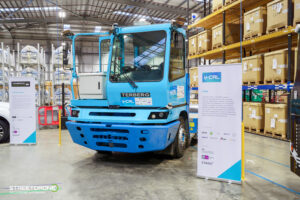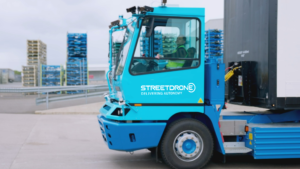Autonomous vehicles have the potential to revolutionise industrial environments, bringing newfound levels of efficiency and productivity. From construction sites to ports, autonomous trucks are dramatically improving operational and environmental efficiencies with faster delivery times and reduced costs in both fuel expenses and labour costs. As companies continue to embrace this technology, what can be expected from autonomous vehicle workflow performance?
In this blog post we will explore how process automation is aiding worker safety while spurring innovation within the industry as well as answering common questions about automated processes such as: What are some of the benefits associated with autonomously controlled vehicles working in slower environments? How does human input help enhance safe operations?
We’ll take a closer look at these topics and more so that you can get all the information necessary for making informed decisions about integrating autonomous vehicle systems into your business!
Overview of the autonomous vehicle industry – what are autonomous vehicles and how have they been developed over time
The autonomous vehicle industry has experienced significant growth over the years. Autonomous vehicles are self-driving cars, trucks, and yard tractors that use advanced technology to control themselves. They are designed to reduce human error on the road, which is responsible for most accidents.
The development of autonomous vehicles started in the 1920s, when researchers began exploring the possibility of using “radio control” to operate cars remotely.
Since then, numerous advancements have been made in the industry, with autonomous trucks and yard tractors making significant strides. These vehicles are aimed at efficiently handling heavy loads over long distances and in complex and dynamic environments. With ongoing research and development, the autonomous vehicle industry is set to revolutionise the way we commute and transport goods.

How can autonomous vehicles be used in slow, off-highway environments such as logistics, ports, mining, agriculture, and forestry operations
The advancements in autonomous vehicle technology have paved the way for exciting applications, especially in industries such as logistics, ports, mining, agriculture, and forestry operations.
Integrating autonomous vehicles in these slow, off-highway environments can provide significant benefits. With the use of this technology, mining companies can increase efficiency and safety in their operations, while agriculture and forestry companies can achieve better yields and improve worker safety. With improved navigation, these autonomous vehicles can work around the clock without the need for human operators, significantly reducing operational costs. As the technology continues to evolve, the possibilities for autonomous vehicles in these industries are endless, offering a glimpse into a more sustainable and efficient future.
Benefits of using autonomous vehicles in these environments – increased productivity, improved safety, and potential cost savings
Autonomous vehicles are revolutionising several industries, from transportation to logistics. The use of these vehicles is becoming increasingly popular due to their significant benefits, which include increased productivity, improved safety, and potential cost savings.
By implementing autonomous vehicles, companies can streamline their operations by reducing the need for human intervention and therefore increasing efficiency.
Additionally, the safety benefits of autonomous vehicles cannot be overstated. Without the need for a human driver, the risk of accidents caused by human error is eliminated.
Finally, the potential cost savings come from the reduction of labor costs associated with traditional driving jobs.
Overall, the introduction of autonomous vehicles in various sectors has the potential to transform the way we do business and live our lives.

Examples of successful implementations of autonomous vehicles in off-highway industries
In recent years, autonomous vehicles have been making waves in off-highway industries. Under the umbrella of projects 5G CAL and V-CAL, led by the North East Automotive Alliance, StreetDrone implemented its autonomous technology into a 40-tonne yard tractor to deliver parts from the operator’s sites to the Nissan car plant in Sunderland. Its abilities to work around the clock and improve safety on the job have been game changers.
This has allowed for Vantec’s operations to run smoothly and efficiently, as well as keeping their workers out of harm’s way. Nissan is currently benefiting from the driverless technology, which ensures parts are being delivered 24/7 and the car plant production line never stops. This is just an example of how autonomous vehicles can provide benefits in a variety of industries beyond just consumer transportation.
Challenges associated with the use of autonomous vehicles in off-highway applications
The rise of autonomous vehicles has revolutionised the way people think about transportation. However, most discussions on this topic focus on highway use cases and overlook the potential challenges faced in off-highway applications.
Off-road environments, such as distribution centres, construction sites, ports or mining locations, pose unique challenges to autonomous vehicles that need to be addressed. These challenges include navigating junctions, barriers, traffic lights or through uneven terrain, dealing with unpredictable weather conditions, and managing the heavy-duty equipment involved in these tasks.
By addressing these challenges, we can unlock the full potential of autonomous vehicles in off-highway applications and create a more efficient and safer future for logistics, construction, and mining industries.

What is the future for autonomous vehicles in off-highway industries
As technology continues to advance, there is no doubt that the future of autonomous vehicles in off-highway industries is bright. These industries, which include logistics, mining, agriculture, and construction, among others, are poised to benefit greatly from the use of autonomous vehicles.
With the ability to work around the clock without rest, these vehicles can greatly increase productivity and efficiency. Not only that, but they can also improve safety by performing tasks that are too dangerous for human operators.
However, there are still many hurdles to clear before we see widespread adoption of autonomous vehicles in these industries. These include regulatory issues, technical challenges, and, of course, the cost of the technology.
Nonetheless, the potential benefits are significant enough that it seems inevitable that autonomous vehicles will play a major role in the future of off-highway industries.
All in all, autonomous vehicles are revolutionising the way slow, off-highway work is done. They can be used to increase productivity, improve safety, and potentially save costs.
Successful implementations of autonomous vehicles in logistics, mining, agriculture, and forestry operations have shown how versatile and capable these machines can be.
Of course, there are challenges associated with their use, such as navigational capabilities and finding ways to integrate them into existing workflows. Nevertheless, autonomous vehicles offer many promising benefits that could help these industries become safer and more efficient.
With further development of the technology and a deeper understanding of its potential applications, future developments may make more jobs viable in off-highway industries while improving the speed and accuracy of tasks performed.




